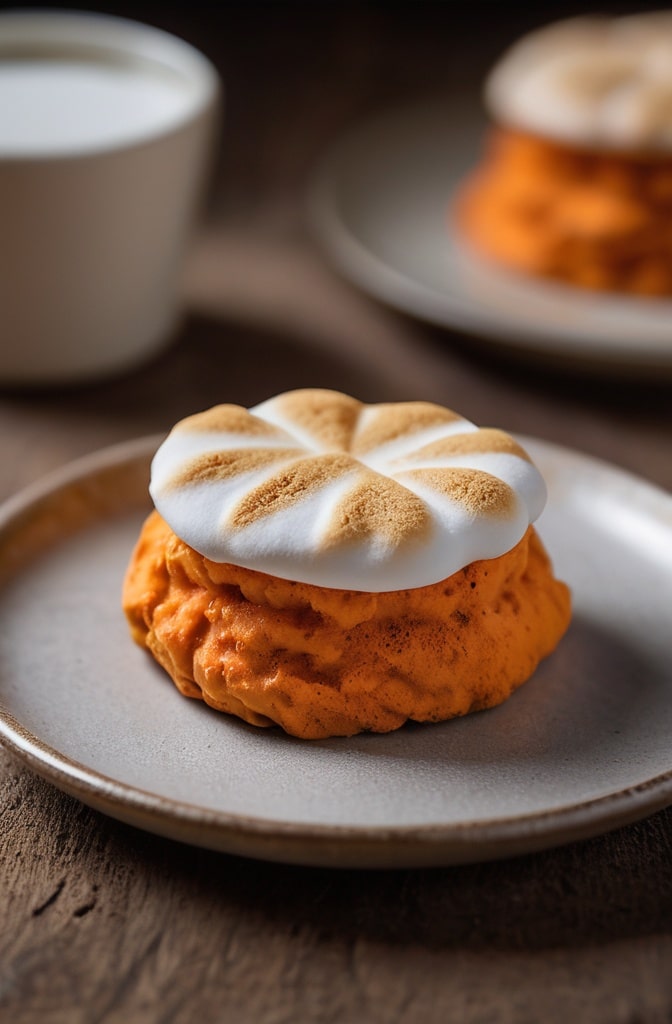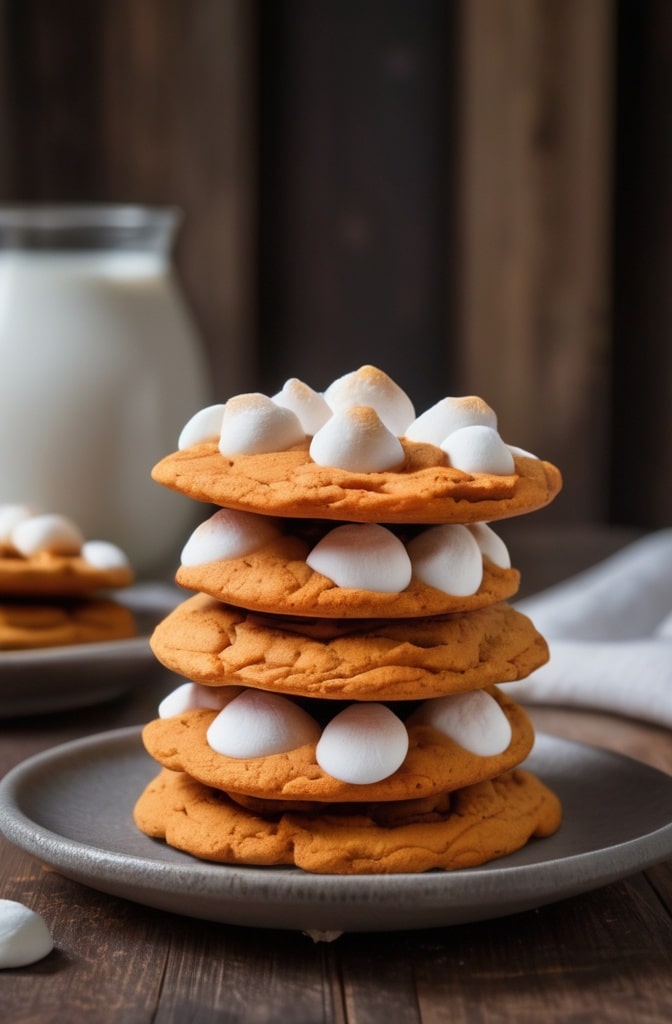Have ya ever caught the scent of roasting sweet potatoes and felt instantly transported to childhood Thanksgiving dinners? That’s exactly the sensation these sweet potato cookies marshmallow topping capture. Last autumn, while experimenting with leftover sweet potato puree (because waste not, want not!), I stumbled upon this gem of a recipe that’s since become my signature treat at professional catering events.
Sweet potato cookies with a marshmallow topping aren’t just another seasonal novelty they’re a sophisticated reinvention of familiar flavors that deserves a permanent spot in any serious baker’s repertoire.
These cookies transform humble sweet potato into something truly extraordinary. They bridge the gap between homestyle comfort and refined patisserie with their tender, spiced crumb and luscious marshmallow crown. What makes them special is the careful balance of textures—soft yet structured cookies that hold their shape, topped with pillowy marshmallow that can be brûléed for an impressive finish that’ll make your guests do a double-take.
Ingredients & Substitutions
For the Sweet Potato Cookies:
- 1½ cups roasted sweet potato puree (approximately 2 medium sweet potatoes)
- 2½ cups all-purpose flour
- 1 teaspoon baking powder
- ½ teaspoon baking soda
- ½ teaspoon salt
- 1½ teaspoons ground cinnamon
- ½ teaspoon ground nutmeg
- ¼ teaspoon ground ginger
- ⅛ teaspoon ground cloves
- 1 cup unsalted butter, softened (2 sticks)
- 1 cup granulated sugar
- ½ cup light brown sugar, packed
- 2 large eggs, room temperature
- 2 teaspoons vanilla extract
- Zest of one orange (optional but highly recommended)
For the Marshmallow Topping:
- 3 tablespoons unflavored gelatin powder
- 1 cup cold water, divided
- 2 cups granulated sugar
- ⅔ cup light corn syrup
- ¼ teaspoon salt
- 2 teaspoons vanilla extract
- Confectioners’ sugar for dusting
The quality of your sweet potatoes is absolutly critical here. Look for Garnet or Jewel varieties—they’ve got the perfect sugar content and that vibrant orange color that makes these cookies visually stunning. Japanese purple sweet potatoes can be an interesting substitution for a dramatic color contrast, though they’re slightly drier, so you might need to add a tablespoon of milk to the dough.
For those with dietary restrictions, coconut oil can replace butter (use 20% less by volume), though you’ll lose some of that rich mouthfeel. Gluten-free bakers can substitute a 1:1 gluten-free flour blend, but add ¼ teaspoon xanthan gum if your blend doesn’t include it—this prevents the cookies from becoming too crumbly and falling apart on the first bite.
The marshmallow component might seem intimidating, but homemade is leaps and bounds better than store-bought. However, in a time crunch, large marshmallows cut in half and placed on cookies during the last 2 minutes of baking will work in a pinch. They won’t have the same ethereal texture, but sometimes we gotta compromise.
Step-by-Step Instructions

Preparing the Sweet Potato Puree:
- Preheat your oven to A425°F. Wash and dry 2 medium sweet potatoes, then pierce several times with a fork. This prevents them from explodin’ in your oven—trust me, it’s a mess you don’t want to clean up.
- Place sweet potatoes directly on the middle rack of the oven with a baking sheet on the rack below to catch any drips. Roast until completely tender when pierced with a knife, typically 45-60 minutes depending on size. Look for a slight caramelization on the skin—this develops those complex sugars that make these cookies special.
- Allow potatoes to cool enough to handle, then split open and scoop the flesh into a food processor. Puree until completely smooth, scraping down the sides as needed. You want to ensure there are no stringy bits that would disrupt the delicate texture of your cookies. Let cool completely before using—hot puree will melt your butter and ruin the recipe structure.
Making the Cookie Dough:
- In a medium bowl, whisk together flour, baking powder, baking soda, salt, cinnamon, nutmeg, ginger, and cloves. The combination of these spices creates what I call the “sweet potato trifecta”—warming, earthy, and slightly floral notes that complement the natural sweetness of the potato.
- In the bowl of a stand mixer fitted with the paddle attachment, cream butter and both sugars on medium speed until light and fluffy, about 3-4 minutes. Don’t rush this step—proper aeration here creates the perfect foundation for your cookies structure.
- Add eggs one at a time, beating well after each addition, then mix in vanilla extract and orange zest (if using). The zest adds a brightness that cuts through the richness, creating a more balanced flavor profile.
- With the mixer on low, gradually add the flour mixture until just combined. Do NOT overmix unless you’re aiming for tough cookies—and nobody wants that! Fold in the cooled sweet potato puree until fully incorporated. The dough will be softer than traditional cookie dough, somewhere between cake batter and cookie dough consistency.
- Cover and refrigerate for at least 2 hours or overnight. This resting period allows the flavors to meld and the flour to fully hydrate, resulting in a more complex flavor and better texture. I’ve found the flavor develops mest when left overnight, so plan ahead if possible.
Baking the Cookies:
- Preheat oven to 350°F and line baking sheets with parchment paper. Using a 2-tablespoon cookie scoop, portion dough onto the prepared sheets, spacing cookies about 2 inches apart. These will spread somewhat, so give them room to grow.
- For perfectly shaped cookies, roll each portion into a ball, then slightly flatten the top with your palm. This technique ensures even baking and a nice surface for the marshmallow topping.
- Bake for 12-14 minutes, until the edges are set but the centers still appear slightly soft. They should not be browned—a common mistake that results in dry cookies. When in doubt, underbake slightly as they’ll continue cooking on the hot pan after removal from the oven.
- Allow cookies to cool on the baking sheets for 5 minutes, then transfer to wire racks to cool completely before adding marshmallow topping. If you rush this step, your marshmallow will melt and slide right off, creating a disappointingly sticky situation.
Making the Marshmallow Topping:
- In the bowl of a stand mixer, sprinkle gelatin over ½ cup cold water to bloom. Meanwhile, combine the remaining ½ cup water, granulated sugar, corn syrup, and salt in a heavy-bottomed saucepan.
- Clip a candy thermometer to the side of the pan and bring the mixture to a boil over medium-high heat, stirring occasionally until sugar dissolves. Once boiling, stop stirring (to prevent crystallization) and allow the mixture to reach exactly 240°F (soft-ball stage).
- With the mixer on low speed (using the whisk attachment), slowly pour the hot syrup into the bloomed gelatin. Be careful—this mixture is extremely hot and can cause serious burns! Once all syrup is added, increase speed to high and beat until mixture is very thick, white, and has tripled in volume, about 10-12 minutes. Add vanilla extract during the last minute of beating.
- Working quickly while the marshmallow is still warm and pipeable, transfer to a piping bag fitted with a large round tip (or simply cut a ½-inch opening in a disposable piping bag). Pipe a generous dollop onto each cooled cookie. The marshmallow starts setting quickly, so have your cookies lined up and ready to go.
- Let the marshmallow set for at least 2 hours before serving. For an elevated presentation, use a kitchen torch to lightly toast the marshmallow tops just before serving—this adds a wonderful caramelized flavor reminiscent of campfire s’mores.
Cooking Techniques & Science
The science behind these cookies is actually quite fascinating. Sweet potatoes contain enzymes that break down starches into sugars during the roasting process, creating that characteristic sweet, caramelized flavor. This natural sweetness allows us to reduce the added sugar in the recipe while maintaining a indulgent dessert profile. Additionally, the moisture content in sweet potatoes produces a naturally tender cookie, almost cake-like in the center, while the edges maintain that desired cookie chew.

When making the marshmallow topping, we’re essentially creating a stabilized foam. The gelatin provides structure by forming a mesh of proteins that trap air bubbles, while the hot sugar syrup cooks the proteins, setting them permanently in their foamy state. This process is called denaturation, and it’s the same principle behind making meringue, except gelatin provides more stability than egg whites alone.
Temperature control is crucial throughout this recipe. When cooking the sugar syrup for marshmallow, even a few degrees above 240°F will result in a firmer, less pillowy texture. I recommend using an instant-read thermometer instead of relying on the cold water test that many older recipes suggest—precision matters here.
For the perfect cookie structure, ensure your butter is truly at room temperature—not melted or too cold. It should yield easily to finger pressure but still maintain its shape. This ensures proper emulsification with the sugars during the creaming process, which creates the air pockets essential for proper leavening.
Serving & Pairing Suggestions
These cookies make a stunning presentation when arranged on a rustic wooden board or slate platter. For maximum visual impact, brûlée the marshmallow tops just before serving, allowing guests to watch the transformation from pure white to golden brown. The slightly bitter caramelization creates a perfect counterpoint to the sweet cookie base.
For an upscale dessert course, serve two cookies sandwiching a scoop of cinnamon ice cream, with a drizzle of bourbon caramel sauce. The warm spices in the cookies complement the creaminess of the ice cream, while the bourbon adds a sophisticated edge.
These cookies pair remarkably well with fall-forward beverages. Try serving alongside spiced apple cider for family gatherings or an aged tawny port for adult dinner parties. The sweetness of the port echoes the caramelized notes in the sweet potato while providing enough tannin to cut through the richness.
For a holiday cookie exchange, package them in kraft paper boxes with a small vial of edible gold dust for recipients to sprinkle on just before serving—this transforms them from homey treats to luxe confections worthy of any high-end patisserie.
Conclusion
Sweet potato cookies with marshmallow topping represent the perfect marriage of nostalgic flavors and refined technique. What makes them truly special is their versatility—they feel equally at home on a Thanksgiving dessert table or as part of an elegant petit four service at a formal dinner.
The keys to success with this recipe are patience (don’t rush the chilling time), temperature control (especially for the marshmallow), and embracing the seasonal nature of the ingredients. Sweet potatoes available in late fall will contain more natural sugars and produce the best flavor profile.
If you’re making these for the first time, don’t be intimidated by the marshmallow component. Even if it doesn’t set perfectly, a slightly softer marshmallow still tastes delicious and lends that signature gooey texture that makes these cookies so irresistible. Remember, in cooking as in life, sometimes the most memorable creations come from happy accidents!
FAQs About Sweet Potato Cookies Marshmallow
Can I use canned sweet potato puree instead of fresh?
You certainly can use canned puree in a pinch, but the flavor won’t be quite as complex. If using canned, drain excess liquid through a fine-mesh sieve lined with cheesecloth for about 30 minutes before measuring. Also, reduce the sugar by 2 tablespoons as canned varieties often contain added sweeteners.
How far in advance can I make these cookies?
The cookie base can be made up to 3 days ahead and stored in an airtight container. However, the marshmallow topping is best made the same day you plan to serve them, as it will begin to weep (release moisture) after about 24 hours. If you need to work ahead, prepare the cookies and make the marshmallow topping just before serving.
My marshmallow didn’t whip up properly—what went wrong?
The most common issue is temperature—your sugar syrup likely didn’t reach the full 240°F before being added to the gelatin. Another potential problem is old gelatin, which loses its setting power over time. Always use fresh gelatin and a reliable thermometer for best results.
Can I freeze these cookies?
The cookie base freezes beautifully for up to 3 months when properly wrapped. However, the marshmallow topping does not freeze well as it changes texture upon thawing. If you want to freeze them, do so without the topping and add fresh marshmallow after thawing.
What’s the best way to transport these cookies to a party?
Due to the sticky nature of marshmallow, these cookies require careful handling. Place them in a single layer in a shallow container with parchment between layers if stacking is necessary. To prevent the marshmallow from sticking to any covering, insert toothpicks into a few cookies to hold the lid or wrap slightly above the topping. Alternatively, wait to add the marshmallow topping until you arrive at your destination if facilities permit.

